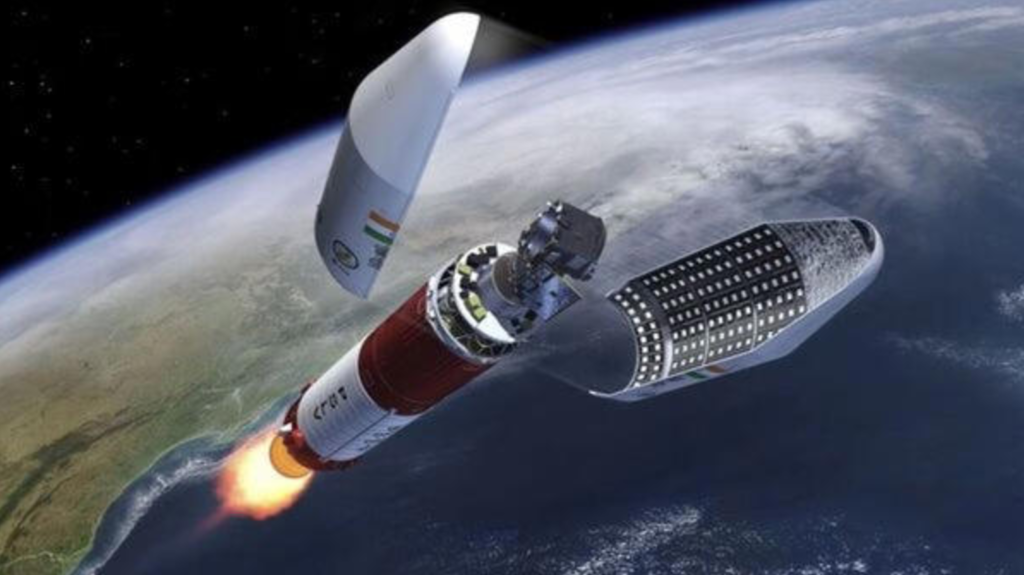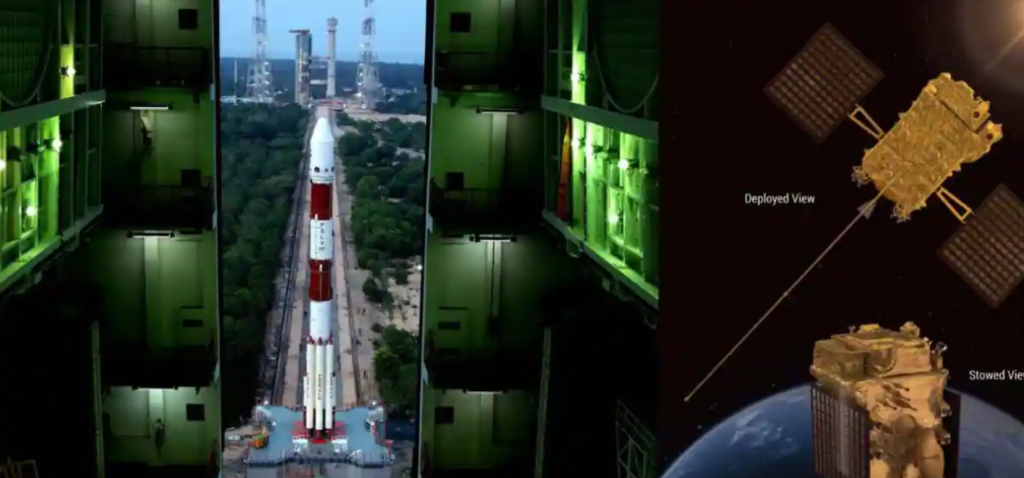
The Sun has been a source of fascination and mystery for humankind since ancient times. Despite the remarkable advances in space technology, observing the Sun’s outer atmosphere, known as the solar corona, has remained a challenge due to the overwhelming brightness of the Sun. Natural solar eclipses have provided occasional glimpses of the corona, but they are rare, unpredictable, and brief. To overcome these limitations, space scientists have embarked on an ambitious project to create an artificial solar eclipse in space.
The Proba-3 mission, a collaborative effort between the Indian Space Research Organisation (ISRO) and the European Space Agency (ESA), aims to achieve this groundbreaking feat. This mission consists of two satellites working together in perfect formation to simulate an eclipse and provide continuous, high-resolution observations of the Sun’s corona.
In this comprehensive blog, we will explore the details of the Proba-3 mission, its scientific objectives, the technology behind it, and its potential impact on solar research and space exploration.
1. Introduction to the Proba-3 Mission

The Proba-3 mission is an advanced space project designed to study the Sun’s corona by creating an artificial solar eclipse. Unlike natural eclipses, which last only a few minutes, Proba-3 will enable continuous observation of the corona for extended periods.
This mission is part of ESA’s Proba (Project for Onboard Autonomy) program, which focuses on developing and demonstrating new space technologies. Proba-3 is unique because it involves two separate satellites flying in precise formation, a technological challenge that has never been attempted at this scale.
2. Why Study the Solar Corona?
The solar corona is the outermost layer of the Sun’s atmosphere, extending millions of kilometers into space. Despite its high temperature—reaching over 1 million degrees Celsius—the corona is much less dense than the Sun’s surface and is relatively dim, making it difficult to observe.
Key Reasons to Study the Corona:
- Understanding Solar Wind: The corona is the origin of the solar wind, a stream of charged particles that affect Earth’s magnetosphere and can disrupt satellites, communication systems, and power grids.
- Solar Magnetic Fields: The corona is shaped by the Sun’s magnetic fields, which influence solar activity such as sunspots, solar flares, and coronal mass ejections (CMEs).
- Space Weather Forecasting: By studying the corona, scientists can improve predictions of space weather events that impact Earth.
- Mystery of Corona Heating: One of the biggest puzzles in solar physics is why the corona is much hotter than the Sun’s surface. Studying the corona could help solve this mystery.
3. Proba-3: A Twin-Satellite System

The Proba-3 mission is unique because it consists of two satellites flying in formation to create an artificial solar eclipse. Each satellite has a specific role in achieving the mission’s objectives.
3.1. Occulter Satellite (OSC)
The Occulter Satellite (OSC) is designed to block the Sun’s light, mimicking the function of the Moon during a natural eclipse.
Key Features of the OSC:
- Occulting Disc: The OSC carries a 1.4-meter occulting disc that blocks sunlight, creating a shadow on the Coronagraph Satellite.
- Precision Positioning: The OSC must maintain precise alignment with the CSC to ensure the eclipse is effective.
- Autonomous Operation: The satellite operates autonomously, adjusting its position in real-time to maintain the eclipse.
3.2. Coronagraph Satellite (CSC)
The Coronagraph Satellite (CSC) is equipped with scientific instruments to observe the solar corona.
Key Features of the CSC:
- Advanced Coronagraph: The CSC carries a high-resolution coronagraph, an instrument that captures images of the corona by blocking direct sunlight.
- Data Collection: The CSC collects data on the corona’s structure, temperature, and magnetic fields.
- Communication Systems: The CSC transmits data back to Earth for analysis.
4. How Proba-3 Creates an Artificial Eclipse
Creating an artificial eclipse in space is a complex process that requires precise coordination between the two satellites.
Step-by-Step Process:
- Launch and Deployment: Both satellites are launched together and then separate in orbit.
- Formation Flying: The satellites maintain a distance of 150 meters between them, with millimeter-level precision.
- Occultation: The OSC blocks the Sun’s light, creating a shadow on the CSC, simulating a solar eclipse.
- Continuous Observation: Unlike natural eclipses, Proba-3 allows continuous observation of the corona for hours or even days.
5. Scientific Objectives of Proba-3
The Proba-3 mission aims to address several key scientific questions related to the Sun’s corona and its influence on space weather.
Primary Objectives:
- Investigate Corona Dynamics: Study the structure and dynamics of the solar corona in unprecedented detail.
- Understand Solar Magnetic Fields: Analyze the Sun’s magnetic fields and their role in solar activity.
- Identify Solar Wind Origins: Determine the origins and acceleration mechanisms of the solar wind.
- Improve Space Weather Forecasting: Enhance our ability to predict space weather events and their impact on Earth.
6. Technological Innovations Behind Proba-3
The success of the Proba-3 mission depends on several cutting-edge technologies that enable precise formation flying and continuous solar observation.
Key Innovations:
- Formation Flying System: An advanced navigation and control system ensures the satellites maintain their relative positions with millimeter accuracy.
- Laser Ranging: Laser-based distance measurement between the satellites ensures precise alignment.
- Autonomous Operations: Both satellites operate autonomously, adjusting their positions in real-time to maintain the eclipse.
- High-Resolution Coronagraph: The CSC’s coronagraph captures high-resolution images of the corona, providing valuable data for scientific analysis.
7. ISRO’s Role in the Proba-3 Mission
ISRO plays a crucial role in the Proba-3 mission, contributing its expertise in satellite technology, ground support, and data analysis.
Key Contributions:
- Technical Expertise: ISRO provides technical expertise in satellite design and navigation systems.
- Ground Support: ISRO’s ground stations support communication with the satellites and data transmission.
- Data Analysis: ISRO scientists will analyze the data collected by Proba-3 to advance our understanding of the Sun.
8. Challenges of Creating an Artificial Eclipse in Space
Creating an artificial eclipse in space is a formidable challenge that requires overcoming several technical and operational hurdles.
Major Challenges:
- Precision Alignment: Maintaining a stable formation with millimeter-level accuracy is extremely difficult.
- Space Debris: Avoiding collisions with space debris while maintaining formation is a constant concern.
- Autonomous Operation: Ensuring both satellites operate autonomously without human intervention requires advanced AI and control systems.
9. Impact of Proba-3 on Space Science and Solar Research
The Proba-3 mission is expected to have a significant impact on space science and solar research.
Key Impacts:
- Advancement in Solar Physics: Proba-3 will provide new insights into the solar corona and its role in solar activity.
- Improved Space Weather Forecasting: Better understanding of the corona will enhance our ability to predict space weather events.
- Technological Development: The mission will demonstrate advanced technologies that can be applied to future space missions.
10. Future Applications of Proba-3 Technology
The technologies developed for Proba-3 have potential applications beyond solar observation.
Potential Applications:
- Space Telescopes: Formation flying technology can be used to build larger and more advanced space telescopes.
- Exoplanet Exploration: Similar techniques can be applied to study distant exoplanets by blocking starlight.
- Interplanetary Missions: Precision formation flying can enable complex interplanetary missions and spacecraft constellations.
11. Conclusion: A New Era in Solar Observation
The Proba-3 mission marks a significant milestone in space exploration and solar research. By creating an artificial solar eclipse, Proba-3 will provide continuous, high-resolution observations of the Sun’s corona, unlocking new insights into solar activity and its impact on Earth.
As ISRO and ESA collaborate on this groundbreaking mission, humanity takes one step closer to understanding the star that powers our solar system. The Proba-3 mission is not just about blocking the Sun—it’s about illuminating the future of space science.

Average Rating